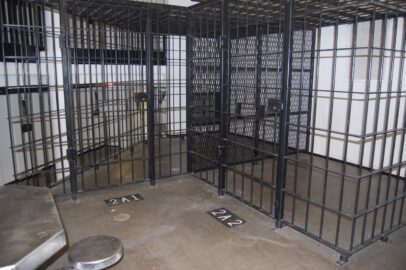“Put a person in that cell. No visits, no phone calls. No books, radio, tv or personal property of any sort to engage them. Put them there in this solitude for months, years. Only there, for 22-24 hours a day. All day, every day. Never knowing when they will get out or what they must do to get out…. That is solitary confinement.”
Staff Post
Luke Woollard

One night in January of 2014, two prison guards at the Colorado State Penitentiary walked a man in handcuffs and an inmate’s uniform down the prison hallway and deposited him in a solitary cell designated R.F.P. Ad. Seg.: Administrative Segregation, Removed from Population. Solitary confinement. His time in that cell would be spent in crushing solitude; inside a small box almost completely removed from human interaction.
He would not be alone in experiencing the quiet brutality of solitary confinement. Across the nation, between 50,000 and 60,000 other people were in boxes just like his, spending 22-24 hours of their day in a cell the size of a parking space. They would eat, sleep, and live penned in by cement walls and a steel door, never more than a few feet from their toilet.
However, this man, unlike the people that I visit as an attorney, ended up only spending 20 hours in solitary. He could do that because he is Rick Raemish, and during his time in that cell in January of 2014 he was the Executive Director of the Colorado Corrections Department. What was he doing in solitary confinement and why did he stay there for 20 hours? We will return to these questions in a moment. First, let me tell you a little about solitary confinement in North Carolina.
The Size of a Parking Space?
In our state, thousands of people are being tortured over months and years, subjected to a cruel and unusual punishment scheme that disproportionately targets people of color and people with mental health disabilities. A few years ago, I thought I had seen just about all there was to see of prisons and jails in North Carolina; from meetings with unhandcuffed clients in empty cafeterias to yelling through bulletproof plastic trying to slide documents through a slit in the wall.

But when I walked into a solitary confinement unit for the first time, any preconceptions I had disappeared. Though I had heard, and repeated, the commonly used description of these solitary cells as “the size of a parking space” (a 6X8 foot cell is hard to picture without a measuring tape), the reality of solitary confinement quickly cuts through this nicety. It hard to imagine a parking space without also imagining a parking lot. A parking space conjures up the image of one open, empty parking space amongst many other spaces in a large outdoor lot, a space unrestricted by walls or doors.
Solitary cells are the opposite. They are crowded, dark closets the dimension of a parking space. Add to that space a solid steel door, an uncovered toilet that is also a sink, a single bed and small metal desk, all bolted to cement walls. Throw in harsh overhead lighting and a translucent window the width of your hand. That is a solitary cell.

Put a person in that cell. No visits, no phone calls. No books, radio, tv or personal property of any sort to engage them. Put them there in this solitude for months, years. Only there, for 22-24 hours a day. All day, every day. Never knowing when they will get out or what they must do to get out. Shrink their life into a walled parking space, make them stay there, with the least control imaginable of their existence or destiny. Make their world whatever comes through the slit in the locked door. That is solitary confinement.
Voices from solitary
During that first visit there, other advocates and I made rounds through the cellblock, knocking on steel doors at every cell and yelling to find out how the men were being treated, what they needed. How can I describe the pure torture I saw looking into those cells?
In the voices from behind the doors you hear desperation. You hear anger and frustration. You hear resignation and hopelessness. You hear people ask for help, not just for themselves but often for people in the cells around them. Sometimes you hear nothing and look in to see someone who has just stopped believing anyone could help them. And that silence may be justified; try as we might, help doesn’t always make it behind the door. People are left to mentally degrade for months and years with no adequate treatment and no way out.
North Carolina lags behind other states
Which brings us back to Rick Raemish. It only took 20 hours in this hell to solidify Raemish’s conviction that Colorado needed to rethink and restrict how and for how long solitary confinement is used. Soon after, he led a successful campaign that ended the use of solitary confinement for more than 15 days, and moved nearly all people with mental health disabilities from solitary confinement into less restrictive settings. His personal experience in solitary led him to completely reform its use as a disciplinary practice in Colorado.
Unfortunately, North Carolina lags significantly behind states like Colorado, as nearly 3,000 people on average are held in solitary confinement at any given time. Yet, it is not too late to act. We have an opportunity to address this dark reality of North Carolina prisons right now.
Recommendations from the Task Force for Racial Equity in Criminal Justice
On December 15, 2020, Governor Cooper’s Task Force for Racial Equity in Criminal Justice produced a set of recommendations that can push North Carolina’s justice system forward into an era of increased racial equity and fairness. Among these was a recommendation that the Governor adopt the Mandela Rules, the UN’s recommendations for the use of solitary confinement, which forbid the use of solitary confinement on people with mental health disabilities, juveniles, and other at-risk groups. These rules also define any time spent in solitary confinement beyond 15 days as torture.
Additionally, the Task Force recommendations recognize that solitary confinement disproportionately harms people of color. North Carolina incarcerates far more people of color than whites compared to the overall population, and data released by DPS shows that people of color are far more likely to have solitary confinement inflicted upon them. In fact, the percentage of people of color serving sentences in solitary confinement increases as the housing assignments become more restrictive. At the most severe housing assignment, where solitary confinement conditions are the most draconian, anywhere from 75-85% of incarcerated people are people of color. Further, there are strong indications that DPS policy and regulations allow implicit racial bias to affect the disciplinary system in ways that lead to a disproportionate number of people of color in long-term solitary confinement.
Summary of Recommendations
- People under 21
- Pregnant people
- People with diagnosed serious mental health disabilities, disability, or substance use disorder
- Indefinite period of times
- Periods of more than 15 consecutive days.
The Task Force’s recommendations are rooted in both science and morality, and if adopted will stop the cruel harm done to people and communities across North Carolina. Solitary confinement is recognized as torture by the scientific and international community because, living under these conditions, nearly all people suffer severe degradation of their mental faculties. They have a significant likelihood of developing conditions like paranoia and depression, some to a severe extent. Especially concerning is that many people put in these cells are already suffering from a diagnosed mental health disability, as people with mental health disabilities are more likely to be placed in solitary confinement. Their disability has been criminalized.
“Beyond the prison walls”: grim statistics
The cruelty and damage that happens behind those thousands of steel doors reverberates beyond the prison walls. Most people who experience long-term solitary confinement will eventually be released from prison and will re-join their communities.
- Over 20,000 of the 30-35,000 people incarcerated in DPS facilities are released every year.
- Many are released straight from solitary confinement, with few resources and no opportunity to re-adjust to civilian life.
- In 2015, nearly 2,000 people were released directly from solitary confinement back into the community.
The torture of solitary confinement continues to harm these people after release. Those who experience solitary confinement are:
- More likely to die within the first year after release than people who served their time in the regular population.
- At increased risk for death by suicide, homicide, and opiate overdose.
As science and case studies repeatedly show, long-term solitary confinement prevents successful rehabilitation, and DPS cannot offer meaningful opportunities to participate in society after release if long-term solitary confinement continues to exist in North Carolina.
Hope for NC
With the NC Task Force recommendations, state leaders and legislators have taken a bold stance against the continuation of solitary confinement and the torture of North Carolinians. However, the recommendations will have no effect without popular support. When Rick Raemish walked out of that solitary cell after 20 hours, no other cell doors opened, and no one else was freed. It took months of dedicated work, inspired by his experience, to end long-term solitary confinement in Colorado.
We as a State must have the will, common sense, and fortitude to meet the goals set by the Task Force. And we must apply pressure at all levels of State government to keep moving toward a penal system free of solitary confinement. Political and cultural barriers, as well as institutional inertia, will push back against any reform efforts to maintain the status quo. But we know, from the example of Colorado and several other states, that reform is not only possible, it is beneficial, and leads to healthier communities.
The people of North Carolina and their elected officials must work together to recognize and act on the truth at the heart of this battle for reform: long-term solitary confinement is torture, and it must stop. Learn more about DRNC’s advocacy efforts in NC’s prisons and jails.
